1. Introduction
[1.1] The emergence of voice, video, and text chat application Discord as a popular social platform has significantly impacted online fan communities. Initially centered on gaming, Discord has evolved into a space for fans of all interests, enabling events such as jams, watch parties, and game nights and facilitating direct interaction with influencers, streamers, and celebrities in servers. Discord has recently prioritized online fandom through its new server monetization features that encourage the creation of fan-oriented, paid-access spaces (Yang 2022). Discord's focus on encouraging and monetizing fan engagement is not unique from other social sites, but its position within the ecology of fandom platforms makes it a distinctive object of study. Discord positions itself between and above other platforms in fan ecologies, facilitating integration with sites like YouTube and Twitch while offering few shareable features off the platform. Discord operates as an ur-platform for fan communities, connecting and networking fans from across other social media sites while retaining them within its harbors.
[1.2] As Discord has sought to reinvent itself for wider audiences and to rhetorically distance itself from its history of hosting white supremacist and hate groups, it has increasingly relied on and promoted celebrities and influencers to establish the legitimacy of the platform. This is perhaps best represented by a now-deleted promotional video called "Discord: The Movie" posted to the official Discord YouTube channel, which featured Awkwafina, Mr. Beast, Danny DeVito, Grimes, and other celebrities encouraging media fans to "imagine a place…full of all of your favorite things…[and] like-minded people to share this passion with" (figure 1) (Keenan 2021). Discord's recent marketing shift reflects its understanding that fandom and the organizing labor fans perform is foundational to the platform.

Figure 1. Still from a Discord ad titled "Discord—The Movie" with Awkwafina and Danny DeVito (Keenan 2021).
[1.3] This article presents a sociotechnical investigation of the fan experience on Discord, attending to how fans use Discord and how Discord uses fans. We argue that Discord shapes fandom in two crucial aspects—power and intimacy—which undergird nearly all aspects of how fans interact and develop community. We analyze how Discord's affordances enable fan intimacies and power structures across three levels of widening scope. First, we narrowly investigate the affordances within individual Discord servers, using the r/Zelda server as a case study. Next, we look at how Discord Nitro and premium features establish intimacies and cultural capital across Discord servers. Finally, we analyze how Discord facilitates the growth and dissemination of fan intimacy and power at a platform-wide level. We offer a comprehensive overview of Discord's affordances and fan practices that position the platform as a nexus of digital fan activity. This research also sheds light on how fans engage with social media platforms and how these platforms shape fan experiences in their pursuit of fandom.
2. What is Discord?
[2.1] Discord, established in 2015, originally aimed to facilitate video and voice communication for online gamers, but it has expanded beyond gaming (https://discord.com/company). Users must first make an account to access different servers. Users can create and join servers, which are community spaces oriented around assorted topics or communities. Users create voice, video, and text channels within servers for communication, often dedicated to specific aspects of the server topic. Servers are either public, accessible to all Discord users, or private, requiring an invite link. Discord also supports the use of emojis, GIFs, embedded links, documents, text, and video chats, functioning like a blend of internet relay chats and forums with additional audiovisual features.
[2.2] In the current landscape of digitally mediated fandom, Discord has evolved into a popular hub for fan communities. Some of the most populous servers on Discord are dedicated to fan communities around games, with the official Genshin Impact, Valorant, and Fornite servers each nearing one million members as of this writing (Hebert 2022). Additionally, there is a significant presence of community-run gaming servers, with games like Roblox and Minecraft having over 60,000 servers each. Beyond gaming, Discord hosts an extensive range of servers focused on media-based fan objects and texts. These fan servers serve a dual function, enabling fan discussion and creative production in a centralized place and fostering social interactions among fans. Thus, Discord lends itself well to traditional fan practices such as sharing transformative works like fan art and fan fiction, but it also doubles as a social community where fans may bond over the fan object. This aligns with previous arguments that emphasize the importance of fan labor centered on the reception of transformative works (Turk 2014; Dym and Fiesler 2018). Discord's platform offers an intimate and interactive space for fans to engage in these activities and form deeper connections within their fandom community.
[2.3] Content creators and influencers have embraced Discord by establishing their official or community-run servers. Many creators actively participate in or even own these servers, leveraging the close relationship they have with their audience. These servers function similarly to traditional fan object servers but offer direct interaction between fans and creators. Fans in these servers may provide feedback to creators, suggest new content ideas, and express their support for them. These Discord servers play a vital role in cultivating the social and parasocial relationships that sustain creators' careers while also deepening fans' sense of intimacy with their favorite influencers.
[2.4] Creators may also leverage Discord's monetization features to acquire financial support from fans. Recent additions like paid server subscriptions give fans access to private spaces and bonus perks such as custom emojis. Discord provides creators with a highly competitive 90 percent revenue split for creators, competing with rival paid-access service platforms like OnlyFans and Patreon. The monetization model represents an important shift in Discord's rhetorical approach to the platform, celebrating content creators and noting celebrity influencers who are making use of its monetization options (Yang 2022). Paid subscriptions are crucial for online creators because, unlike traditional celebrities, they rely almost entirely on digital affordances to cultivate their fandoms. As their fans cultivate community exclusively through online platforms, paid features present another opportunity for them to strengthen connections with their favorite creators—therefore upholding financial investment as a vehicle for intimacy.
[2.5] Discord's company position on the purpose of servers echoes the many uses and gratifications that fans find in joining them. Discord describes most servers as "private, invite-only spaces for groups of friends and communities to stay in touch and spend time together" (https://discord.com/safety/360044149331-what-is-discord). This corporate discourse promotes a sense of close-knit intimacy within servers, fostering trust and affection among members. However, it also allows loosely moderated servers to circulate anything from hate speech to classified government documents. Discord, with its dual focus on large networks of fandom servers and smaller servers focused on fan community and conversation, slots cleanly into the history, platforms, and power struggles that have shaped fandoms and internet cultures more broadly. Discord operates as a developing site of fandom with similar issues of intimacies and power structures as other social media platforms.
3. Fandom, power, and intimacy
[3.1] Fan scholars have explored how fandoms are embedded within and produce power structures and intimacies. Even if fandoms are digital and anonymous, external structures affect how fandoms are produced and circulated. As Jonathan Gray and colleagues have argued, fandoms are "embedded in the existing economic, social, and cultural status quo" (2007, 6) and often replicate societal hierarchies. Thus, rather than being insulated from social institutions, fan communities are microcosms of broader structures that produce economic and cultural intimacy with fan objects. The lived experiences of fans thus carry into their fan practices, making fan identity and personal identity inseparable from one another.
[3.2] Fan practices and identities are predicated on the capital accumulation of individuals. John Fiske identifies fan culture as operating under a "shadow cultural economy" that is stratified through capital possession (1992, 30). He distinguishes between official cultural capital, which is "socially and institutionally legitimized," and popular cultural capital, which is "produced by subordinate social formations" (31–33). Such forms of capital may inform but not necessarily translate into one another: one could attain popularity in mainstream circles but not in niche communities, and vice versa.
[3.3] Struggles for capital are further reflected within digital fan spaces as fans congregate on social media platforms and form online communities. Social media platforms, via their sociotechnical affordances, offer fans opportunities to accumulate social capital (Gil de Zúñiga, Jung, and Valenzuela 2012; Ellison, Steinfield, and Lampe 2011), and provide public and private ways of measuring their influence. Bertha Chin (2018) argues that fans are motivated by reputation, which is often visibly built through public engagement with their posts. Platform affordances such as reposts, likes, and views contribute to fan capital, reinforcing identity and authenticity as fans—in turn transforming fan capital from an abstract concept to a quantifiable metric. Like other platforms, Discord provides a more intimate space for the discussion and sharing of fan works that can be less public-facing while still allowing for the generation of capital (Turk 2014; Dym and Fiesler 2018).
[3.4] Platform moderation plays a pivotal role in shaping these power dynamics, occurring at both platform and server levels in Discord. At the platform level, Discord seeks to enforce broad policies regarding hateful content and illegal activities, policies shaped over time as Discord has repeatedly been forced to reckon with its history of cultivating extremist groups, including the white supremacists who organized the deadly Unite the Right rally in 2017 (Heslep and Berge 2021) and extremist Jack Teixeira, who leaked highly classified US military documents in a Discord server. Yet on Discord much of the labor of moderation is placed on the community managers and server administrators (Jiang et al. 2019; Seering et al. 2022) who enforce their policies and rules. Although larger servers on Discord often make use of technical and social affordances to perform thorough moderation, many smaller Discord communities exist largely unmoderated. James Brown and Gregory Hennis (2019) noted that this practice of outsourcing moderation responsibility to users opened opportunities for hateful conduct to dominate the platform. As Adrienne Massanari (2015) has pointed out, the hands-off moderation approach espoused by Reddit enabled and encouraged the proliferation of toxic subcultures like Gamergate, and Discord has run into similar issues.
[3.5] Thus, social media platforms function as a space in which fandoms must articulate themselves and produce hierarchies of power around the structure of the platform. This study is in conversation with the work of platform scholars, particularly those who have explored how platforms negotiate and massage their own identity as platforms (Gillespie 2010). Previous scholarship has examined how user–platform dynamics shape moderation practices and vice versa (Seering et al. 2022; Jiang et al. 2019; Massanari 2015), but we are interested in exploring broadly how Discord shapes and is shaped by fan behavior within broader social media ecologies. To this end, we explore the affordances of Discord, both the "functions attached to a given object—what, potentially, that object affords" as well as the perceived affordances or "features that are clear to the user" (Davis and Chouinard 2016, 242). Because affordances are nondeterministic (Nagy and Neff 2015; Shaw 2017) and users often engage with platform structures in ways that diverge from the intended use, it is important to understand how the use of a platform arises in practice. Such work engages methods put forth by platform studies scholars who rely on mixed-methods social network analyses of cross-platform dynamics (Burgess and Matamoros-Fernández 2016). To this end, we perform both a vertical and horizontal analysis of fan practices on Discord, focusing both on the affordances that shape fan participation within and across servers and how Discord itself sits atop other social platforms.
4. Fan power and social media platforms
[4.1] To understand power and intimacy on Discord, we first must consider how fandom functions as a "technology agnostic community" across and between platforms (Dym and Fiesler 2020, 2). Fandom behaviors and power structures shift between platforms in response to diverging and developing needs and desires. Examining Discord in contrast to other major fan platforms reveals its unique position regarding fan intimacy and platform-infrastructure–driven power structures. In doing so, we highlight how Discord draws from the features and practices of other fan platforms, including LiveJournal, Twitter, and Reddit, while establishing its distinctive position within digital fan ecologies.
[4.2] Discord follows a lineage of the social media sites that have shaped how fandom operates online, with LiveJournal as a significant predecessor in the 2000s and early 2010s. LiveJournal offers features common to many fandom sites, including blog posts, direct messages, and community hubs, where fans shared, commented on, and archived transformative fan works (Fiesler and Dym 2020; Lothian 2013). Although LiveJournal has some community features, an individual's account often became the locus of fan behavior, shifting away from the affordances of topic-centered fan spaces like chat rooms (Busker 2008). LiveJournal waned in mass and fan popularity during the 2010s, but its impact on digital fandom can be seen in popular sites like Twitter and Tumblr now. On these sites, users discover and participate in various fan communities by following, liking, and retweeting individual users. Fan communities are discovered by actively searching for other users with shared interests. Twitter and Tumblr also amplify posts based on follower count, in turn encouraging users to construct fandom-specific accounts to find and gain traction within specific fan communities (Kehrberg 2013). Rhiannon Bury (2016) found the emphasis on clout and follower counts on these sites caused some users to feel disconnected from fandoms on these platforms, despite enjoying the fan content there.
[4.3] In contrast to these platforms, Discord's main feature is servers that are often organized around specific fan topics, making specific fan spaces distinct on the platform. Users follow servers instead of individual accounts, making the servers the focus for prominence and spreadability, akin to early chat rooms and mailing lists (Busker 2008). Reddit is a social media site similar to Discord, which uses chat rooms called subreddits and allows community moderators to manage user participation in the subreddit (Lynch 2020). However, Discord distinguishes itself from Reddit through server privacy. Reddit sites are accessible to anyone whereas Discord servers require an invite link, offering a more private but encompassing fan space. Despite this privacy, some of Discord's functions mirror the experience of an all-in-one space that encompasses the totality of fandom life as LiveJournal once did.
[4.4] As a platform, Discord thus follows the lineage of prior social media sites while implementing new affordances. We argue that understanding Discord and/as a platform fandom requires an interrogation of the nexus of user practices, Discord technologies, and discourses on the platform. To consider how Discord's digital affordances construct intimacies and power within fan communities, we use André Brock's (2018) critical technocultural discourse analysis (CTDA), which focuses on "evaluating technologies as an assemblage of artifacts, practices, and cultural beliefs" (1014). Combining CTDA with critical fan studies, we explore how Discord fosters intimacy and power within fan spaces at three levels: within servers, between servers, and across the platform. We also consider how fan practices and beliefs about fandom further reify this discursive intimacy and the power hierarchies in Discord spaces.
5. The Discord server
[5.1] This section analyzes the r/Zelda Discord server (https://discord.gg/rzelda), using Brock's CTDA to explore how its interface shapes fandoms as intimate communities with embedded power hierarchies. The r/Zelda server was chosen as a case study due to its representation of Discord's origins in gaming communities and its use of gamified features like the leaderboard system to rank fans and foster intimacies among members. The analysis of the r/Zelda server shows how Discord continues to appeal to fan communities and practices beyond self-identified gamers, continuing to blur the boundaries between gamers and fans (Johnson and Salter 2022). Although not indicative of how all fandoms use Discord, the r/Zelda serves as an exemplar of how Discord communities use the platform's affordances to distribute power and develop in-group intimacies. As Chin notes (2008), fandoms of specific texts are difficult to hierarchize en masse because fans use and migrate across various digital platforms and in-person communities and events. However, Discord servers enable explicit hierarchization not found on other platforms.
[5.2] Before even entering the r/Zelda server, users must agree to the server rules, which offer one method of establishing hierarchy and fan intimacies. That is, to access the channels, users must agree to the server rules, which emphasize the server's values and reinforce moderator authority. For example, to access channels in r/Zelda, users must agree to server rules that prohibit hate speech, pornography, and raiding other servers; violating these rules can result in reprimands and bans. The rules reflect the community's accepted norms and require individual users to conform to them while positioning this Discord fan server as one that upholds those values. Simultaneously, the rules reinforce the moderators and administrators as overseers of acceptable behavior. This dual function fosters a sense of in-group intimacy among the members, who share common values, while centralizing the power of community membership with the moderators.
[5.3] After entering the r/Zelda server, members are assigned roles by administrators, moderators, and bots that determine what channels they have access to and what actions these users can take within each channel. Users can hold multiple roles, visible to all members on the Member List. On the left side are the channels, serving as message boards accessible to members. Moderators and administrators define permissions for each channel, including access, posting, and audio/video sharing. The selected channel's conversation appears in the center of the screen (figure 2).
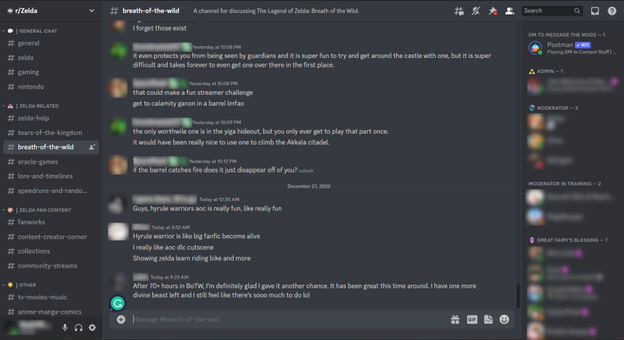
Figure 2. Screenshot of the "breath-of-the-wild" channel in the r/Zelda Discord server. The profiles are blurred for privacy.
[5.4] Discord's affordances enable and encourage users to construct hierarchies and intimacies through roles and channels by ranking the members, regulating conversations, and establishing exclusive channels. These features reward active users by granting intimate access to exclusive spaces. Although moderators wield more power, users of all roles can influence discourse regulation in these areas. Roles and channels thus serve a dual function, regulating engagement through power distribution and fostering tight-knit communities with exclusive features.
[5.5] Discord also differs from platforms like Twitter and Tumblr by explicitly shaping power dynamics through server roles. Unlike those platforms where influence depends on post reach and engagement, Discord's power structure partially relies on defined roles within each server. Role permissions dictate user actions, from managing the server's appearance to moderating messages and voice channels. The flexibility in role permissions enables intricate power distribution within servers unavailable on other platforms. Roles also create intimacies between users of similar stature, allowing members with higher statuses to access smaller channels.
[5.6] In the r/Zelda server, users do not receive a role immediately after accepting the rules. Instead, they can gain roles by earning experience points through interactions in channels, tracked by the Mee6 bot. Mee6 assigns experience points for various actions, and users level up after accumulating a certain number of points. At level 1, members attain the Pictobox Rank role by posting around ten messages in the server's channels. This role grants access to additional features such as posting images, using emojis from other servers, and accessing a channel for further profile customization. Upon reaching level 10, members acquire the next role, which enables screen sharing in voice channels and access to additional channels. Additionally, the r/Zelda server bestows a special Great Fairy's Blessing role on members who use Discord Nitro to boost the server. Users can track their levels and view an experience points leaderboard by using specific commands in a designated chat.
[5.7] In r/Zelda, roles play a crucial role in shaping both the sense of intimacy and the power dynamics of the community. These roles are all tied to Legend of Zelda games and characters, with more specialized roles becoming available at the level 1 rank. Cosmetic roles like Bokoblin, Subrosian, and Fierce Deity allow members to showcase their love for specific objects and characters, and roles like Keaton and Tri Force Hero send notifications to members interested in particular games or activities within the server. These roles foster a sense of community by signaling ongoing interactions in r/Zelda's channels and cultivating smaller, close-knit communities within the larger server. Roles also serve as markers of contribution, with higher-ranked members earning more points for their frequent participation within the various intimate subcommunities in r/Zelda. The Mee6 leaderboard function publicly highlights prominent community members, making their status visible to all server members (figure 3). Other fan communities on various platforms have similar hierarchies (Chin 2018; Kehrberg 2015), but Discord makes these hierarchies more explicit through its role colors and leaderboards. Although these rankings may not directly dictate individual user behavior, they significantly influence the conversations, features, and channels accessible to members and play a pivotal role in shaping the intimate communities that develop within the server.
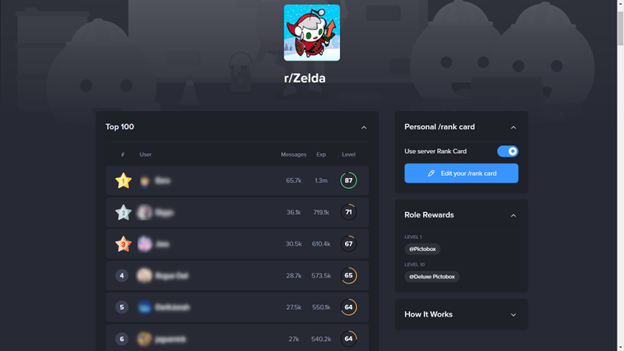
Figure 3. A ranking of r/Zelda users' experience points through the Mee6 (2022) bot. Profiles have been blurred for privacy.
[5.8] Discord channels significantly influence the dynamics of intimacy and power within servers by providing dedicated spaces for specific fan discussions and setting guidelines for appropriate discourse. In the r/Zelda server, the channel structure starts with administrative discussions and announcements at the top, followed by broad interest channels like #nintendo for Nintendo-related news. More specialized topics such as fan art and content creator discussions are further down the list, with voice channels at the bottom. Discord's channel system works with the roles function to allow fan communities to congregate around specific subjects, leading to the creation of subcommunities. In r/Zelda, channels dedicated to specific Zelda games, online multiplayer coordination, and speculation about future titles are particularly active, facilitating connections and fostering intimacy among members who share these interests. Moderators and administrators have the authority to determine appropriate topics for each channel, often providing detailed descriptions of acceptable discussions, which helps them regulate and define appropriate fan behaviors (Chin 2018). Channels create distinct spaces for community engagement, fostering intimate connections between community members through the very tools that establish moderator authority.
[5.9] The combination of rules, roles, and channels in a Discord server establishes a framework of affordances that nurture intimacies and power hierarchies within fan spaces on the platform. These features help maintain order and structure while also enabling the formation of communities centered around shared values, topics, and fan interests that members are passionate about. Discord's platform design intentionally encourages power structures that differentiate and rank community members, which also facilitates the construction of intimate subcommunities within larger servers. The rules, roles, and channels within Discord servers play a pivotal role in shaping the dynamics of power and community formation. Critically, these features are provided by Discord but are molded by its users' practices because Discord heavily relies on community moderators and norms to regulate behavior within individual servers.
6. Discord Nitro and fan experience
[6.1] Discord's new monetization strategies—specifically its paid subscription service Discord Nitro—are crucial to how power is shaped in fan communities. This section analyzes how Discord Nitro and the use of custom emojis distinctly form power structures and intimacies that operate within and across fan servers, imbuing certain fan servers with greater power in the ecosystem. While several social media sites, including Twitter, Reddit, and LiveJournal, now offer subscription services, Discord's affordances allow users to display their cultural and financial capital within and across servers.
[6.2] Discord Nitro is a subscription service that provides users with features that expand or upgrade the way that they can interface with Discord as a platform. As these features are built into the infrastructure of Discord, they can shape the way that fandom spaces run on the platform. Discord Nitro is the primary way by which Discord is monetized; in 2020, Forbes estimated over one million users were subscribed to Discord Nitro (Abram 2020). Currently, there are two plans: a $2.99/month basic plan enabling emoji use across servers and increased upload limits and a $9.99/month premium plan offering these features, profile customization, and server boosting. With a premium Nitro subscription, Discord users are given two free boosts to the servers of their choice. Boosts are accumulative; the more boosts a server receives, the more features are unlocked for it. These features include more slots for server emojis and stickers, custom banners for the server, an increased upload limit for all server users, and more (figure 4).
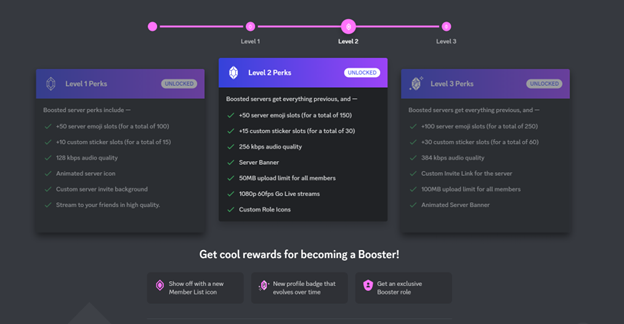
Figure 4. Server boost perks. Higher levels gain better audiovisual quality and more emojis, among other benefits.
[6.3] Boosting provides several visual indicators of hierarchies across fandom servers while facilitating the formation of intimate communities around shared aesthetics and symbols. Boosters are designated with an icon next to their name, signifying their financial investment and dedication to the community. Boosted servers stand out from others centered around the same fan object, offering enhanced customization options, including fonts and colors. These features allow boosted servers to position themselves as having greater economic and social capital while fostering shared messaging and aesthetics to cultivate intimate communities. Boosted servers may also have more custom emojis, enabling more symbols and forms of communication that strengthen intimacies between members of the same server. Discord Nitro allows users to leverage economic power to promote and distinguish certain fandom spaces as servers showcase their aesthetic choices, such as banners and URLs, to highlight their distinctiveness. In this way, the infrastructure of Discord affords intimacy through shared symbols unavailable elsewhere, linking community intimacy with economic power in ways unavailable on other social media platforms.
[6.4] Custom emojis often motivate Nitro purchases and server boosting. Custom emojis are dense symbols of cultural and economic capital on digital platforms (Graham 2019). Moderators on servers can create specialized emojis that align with the fandom, aesthetic, and humor of the server. This is a potent affordance unique to Discord in its ability to foster a communal identity within individual servers. These emojis, many of which take the form of easily identifiable memes, serve as condensation symbols (Graber 1976) densely packed with feelings of intimacy and community belonging. As condensation symbols, the emojis represent shared symbols and identifiers, some shared with other servers and others unique to the server itself. For example, the r/Zelda server has 300 emojis, about half of which are only available to boosters (figure 5). These custom emojis help individual users maintain social identity and communal relations with a fan group through their use of commonly recognized symbols (Edwards 2022), thus acting as a form of social currency for individual server members.
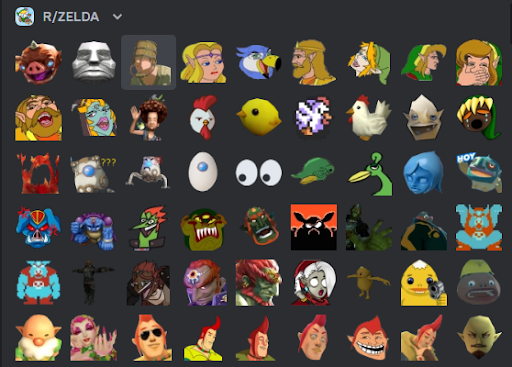
Figure 5. Custom emojis from the r/Zelda Discord server.
[6.5] Nitro subscribers can also flex their social and economic capital by using custom emojis across servers. The act of using custom emojis can even serve as a recruitment tool: others may inquire about their origin and seek invitations for the corresponding servers. Dedicated emoji servers have emerged to cater to fandom-specific emotes, highlighting emojis as status symbols (figure 6). Emotes and stickers also foster intimacy as users collectively express their reactions with emojis from their fandoms and other server memberships. Thus, Discord Nitro and custom emojis further center power structures and intimacy within fannish practices on the platform as fans move across and between fan servers. As in individual servers, users on Discord work with its affordances to shape how intimacy and hierarchies are distributed across the platform.
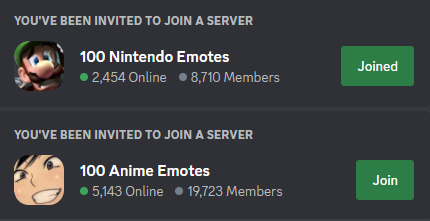
Figure 6. Invitations to two fandom-specific emoji servers.
7. Platform-wide fan experience
[7.1] Intimacy and hierarchies operate clearly on the individual server level but are more difficult to see on a broader scale on the platform. Discord's digital ecosystem, interconnected by people (moderators, shared users, influencers), technology (bots, webhooks, emoji), and culture (shared fandom and practices), shapes fan power and intimacy. In this section, we again expand our scope to consider how practices and affordances across the entire Discord platform affect and produce hierarchies and intimacies for fans. Daniel Heslep and P. S. Berge (2021) have noted that white supremacist groups on Discord operated across entire networks of servers, building complex multiserver checkpoints and recruitment pipelines, while other groups formed raiding parties to harass other servers. Similarly, while much of the fan experience on Discord is contained within communities, power and intimacy are also shaped by the networked nature of Discord's ecosystem. As we demonstrate, fandom on Discord extends far beyond any one server. Rather, it becomes an unfurling canvas of intersecting fandoms, people, and technical actors.
[7.2] Fan communities on Discord are first linked by people, as users' reputations may follow them across servers. A moderator on a gaming server, for example, may have his or her power acknowledged within other gaming communities, and it is not uncommon for established moderators to be tapped to help run new game-centered communities by developers and publishers. In this way, a successful community manager or moderator does not simply coalesce power within one community but builds a larger reputation within a fandom across communities for their role as a proficient administrator. At the same time, ne'er-do-wells may find themselves preemptively blocked from communities managed by the same moderating teams. In this sense, power extends between servers because the reach of users extends between servers. At the same time, intimacy also travels on Discord. For example, clicking another user on Discord allows one to view what other servers that person has in common, a way to see how fandom interests may overlap. Such a practice connects users across communities with similar interests and fandoms.
[7.3] A user's Discord profile is crucial to how individuals build their reputation across the platform. Nitro Premium enables users to change their profile image, bio, and banner on a server-to-server basis, allowing users to tailor their profile to each fandom server. Through profile customization, users can demonstrate how they belong to the in-group of a fandom, their financial power working in tandem with the platform to demonstrate a sense of inclusion and belonging. Through customization, fans can verbalize their identity and interests more clearly and find others with similar interests and aesthetic leanings. Users who customize their profiles interface with the affordances of Discord to produce a sense of self that reflects their technological and fiscal capital. Within a fandom, Nitro premium users can produce a chameleon-type flow from fandom space to fandom space, altering their profile to map appropriately onto the space they occupy. Fans thus shape and are shaped by the affordances of the platform as they use Discord Nitro to produce themselves as fans with superb technical, economic, and social capital within fan spaces.
[7.4] At the same time, communities on Discord are linked by technical actors like bots and webhooks. As mentioned previously, bots are automated tools meant to run within Discord communities that augment the affordances of the space. Discord creates and owns some bots, but most bots are user created and shared on platforms like GitHub for easy implementation by server moderators. Bots appear in-server much like regular users, but they perform complex tasks and are prompted with chat-based commands or other event triggers. Bots are commonly used for music, games, moderation, recruitment, event planning, and more, but bots are also agents of power and intimacy. Moderators can choose whether to post information as themselves or use a bot, giving them newfound legitimacy. Many bots also manage server roles through an autorole function, meaning that the bot can grant and distribute access through verification roles and even punish users, such as with mute roles that prevent the user from posting. Some bots retain user information across servers, allowing members to earn collectibles and experience points (XP) across servers. For example, Pokémon fans may use the popular Pokétwo bot to catch, trade, and level up Pokémon and battle other members across servers (figure 7). Bots are so ubiquitous on the platform that the most popular bots like Mee6 and Carl-bot have websites and premium memberships, further enmeshing bots within economic systems on Discord.
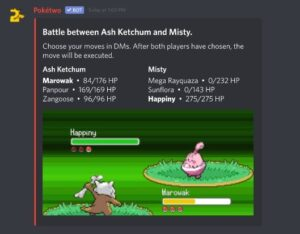
Figure 7. A battle between two members in a server using the Discord bot Pokétwo.
[7.5] In seeking to assert itself as a kind of metaplatform for fandom, Discord has added numerous ways to hook into other social media platforms. Webhooks are a crucial way platforms link into existing digital fan spaces outside of Discord. For example, music fans can connect their Spotify accounts to display what they are listening to at any time, and video game fans can link their Steam accounts to display their usernames and how many games they own. The webhook feature likewise allows for content from websites such as Twitter and Patreon to automatically post to a Discord server. For example, the r/Zelda Discord server hosts a channel dedicated to updates from its subreddit, linking the two sites together and forming an intimate connection with external users. Servers can also be integrated directly with Twitch, allowing members to engage in live-streaming watch parties on both Twitch and Discord channels. For influencers on Twitch and YouTube, it is not uncommon to broadcast directly into their Discord servers, creating an inner circle effect for those watching. Discord is also slowly integrating new functions that allow for paid subscriptions to work across platforms like Patreon and Twitch, making the webhook an essential economic tool for celebrities and influencers who want to grow a following and make money from their Discord servers.
[7.6] Finally, it is worth noting that fandom itself becomes a point of connection for Discord servers. Although it is common for brand-affiliated media to have official or partnered servers, the presence of more niche, intersecting, and splintered fan servers is ubiquitous on Discord. For example, fans of ND Stevenson's popular animated show She-Ra and the Princesses of Power may belong to the official She-Ra server or one of the hundreds of other servers tagged with She-Ra on Discord. As seen in the server-network visualization in figure 8 collected with the Disboard Scraper and Analysis Notebook (Berge 2022), dozens of She-Ra servers intersect with other fandoms, including other animations (Gravity Falls, Owl House), anime (My Hero Academia, Avatar: The Last Airbender), and games (Dungeons & Dragons, Pokémon). Some of these servers are dedicated to art, zine-making, or other fan practices, and others are targeted toward specific demographics (LGBTQ+ people, people of color, moms, etc.).
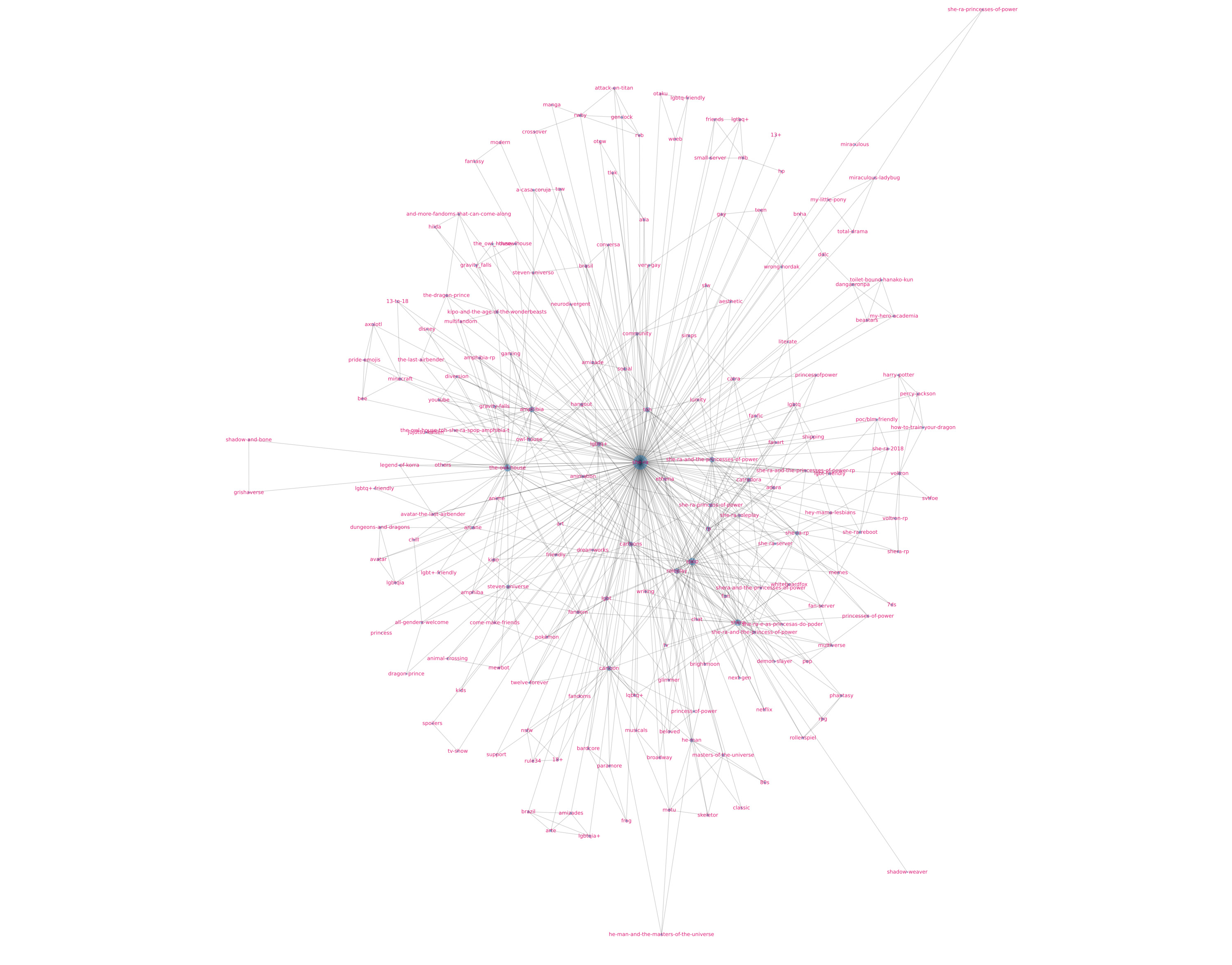
Figure 8. A server-network visualization of "She-Ra" servers listed on Disboard.org. Collected using the Disboard Scraper and Analysis Notebook (Berge 2022).
[7.7] Here we can see how Discord is a platform in which fandom is forced to be in conversation with the platform itself, where the monetary and architectural choices made through the platform have a noted impact on the way that fans can articulate and define their spaces. But in return fans, through bots and webhooks, cause Discord to be rearticulated on its terms. Fans leverage the platform's capabilities to connect across servers and social media platforms, actively shaping individual servers and Discord as a platform through their custom bots and webhooks. Discord and fans become intertwined on the level of the platform architecture, a space of negotiation and development as both create new ways of interfacing with and using the platform.
8. Conclusion
[8.1] We have examined how Discord's features and fan practices shape power structures and intimacy across three levels. First, within individual servers, rules, roles, and channel practices shape and govern fan interactions, enabling the establishment of hierarchical structures and regulation of fan discourses. This fosters intimate communities by promoting similar behavior among members and creating specific subcommunities within servers. Across Discord servers of the same fan text, fans share their love of fan objects while displaying their individual and fan community's cultural and economic capital. Discord's subscription service Nitro encourages and facilitates the construction of specifically powerful communities by providing ever-increasing awards for investment, including the intimate in-jokes of customized emojis. Finally, profile customization, webhooks, and discourses about fandoms and fan objects construct broad networks of power and intimacy across the entire Discord platform and beyond.
[8.2] We additionally emphasized the connections between access, power, and intimacy. As previously stated, Discord supplies a variety of technical tools that fans may use to foster community. Fans enjoy a high degree of personalization on the platform, from customizing their profile appearances to using custom emojis across servers. However, this technical access is contingent on the preexisting degrees of power and intimacy in such communities—a fan with more social and cultural capital can acquire roles that unlock privileges within the server, and the exercise of these privileges in turn boosts the fan's capital. Technical access often denotes established power and intimacy, yet power and intimacy are necessary keys to technical access. Furthermore, the discussion has illustrated the close ties between technical access and economic capital. Several paid features, such as Nitro and server subscriptions, enhance fans' community-building experiences. Thus, the question of access on Discord is not isolated to its technical affordances but to how these affordances give fans access to the formations needed to build power and intimacy. The structure of relationships in Discord servers is mediated by its technical affordances, which are often themselves mediated by financial investment. Access, then, is a sociotechnical issue on Discord created by the interplay between technology, money, power, and intimacy.
[8.3] Our study has further emphasized Discord's distinct role within larger social media ecologies. Content created elsewhere is meant to be shared on Discord, but content and conversations within Discord are designed to remain internal. As a result, Discord is attempting to situate itself as a kind of digital ocean for online fandom—the destination to which all other algorithmic rivers run. For fan and platform scholars attending to fan practices on Discord, it remains insufficient to examine fan behaviors within isolated servers or even contained within Discord's infrastructure: further investigation is required of the ways that Discord interacts with, hooks into, signal boosts, and redirects fan practices on connecting platforms.
[8.4] Discord represents a broader shift in the relationship between fandoms and platforms. Discord's Nitro service and server subscriptions are part of a growing economic model centered around subscription-based consumption and the monetization of fan communities. This model allows members with greater financial resources to position themselves with more cultural capital within digital fan communities. Bots and webhooks on Discord highlight how fandoms connect across various social media platforms in often disjointed ways. User-generated creations like bots also serve as examples of fans leveraging their expertise to shape social media platform functionalities and practices. By exploring these various affordances and fan practices, fan scholars can focus new attention on how social media platforms are consolidating fan power and intimacy in ways that might be dangerous, innovative, and certainly worth paying critical attention to.